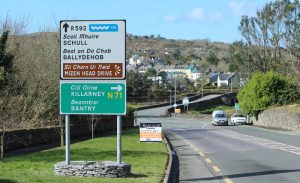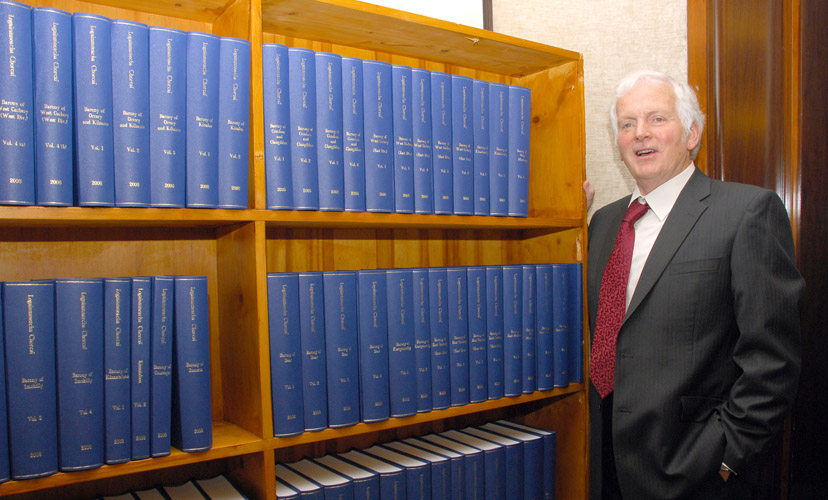

1. Objects and the organising of the survey
Cork Place Name Survey was established in 1996 by Dr. Éamon Lankford to undertake the collection and mapping of the minor placename heritage of Co. Cork.
The objects were:
1. To organize the countywide collection and mapping of all kinds of names from oral and documented sources.
2. Create Ireland’s first public Place Name Archive at Cork County Library by 2009.
3. Influence the development of a code of Best Practice for the creation of appropriate placenames by Local Authorities, Planners and Developers.
4. Engage with community groups and educational institutions to have the study of Irish placenames become part of a conscious effort to preserve local identity and also become a serious course of study at Third level.
With the objectives clear and the Methodology focused entirely on collecting and mapping the location of placenames the voluntary Place Name Survey group had a Planning and Day to Day Operation and Management structure. That was known as Logainmneacha Chorcaí / Cork Place Name Survey. Each member of the Steering Committee was allocated a special task and an Advisory Council of people representative of the National Training Authority, university and library interests was composed of people from Co. Cork.
The Survey Team, consisting of administration personnel, researchers, fieldworkers, IT assistants, cartographers and a word processing team was trained by Seanchas Research, a partnership between The Irish National Training Authority and the Cork Place Name Survey organization. The organising and co-ordination of the survey was carried out under the direction of Dr Éamon Lankford at An tÁras, 13 Dyke Parade, Cork. The county placename collection and mapping initiative was based on the methodology devised by Éamon Lankford and operated at Cape Clear and other West Cork islands in the years from 1976-to 1990.
The collection and mapping of the placenames heritage of the civil Parish of Cape Clear Island Co. Cork by Dr Éamon Lankford was the template for the placename survey of all Parishes and Townlands in Co. Cork, Ireland.
Over 2,000 names for natural and cultural features were collected in the placename survey initiative in Cape Clear. That collection is presented in the Placename Collections section of this website.
2. Organising fieldwork and oral sources
The collecting and mapping of placenames from oral sources was a fieldwork initiative organized townland by townland with the assistance of hundreds of teachers, and a few thousand Primary, Postprimary students, parents and Third Level students. Community development organizations, historical societies, farmers, postmen, fishermen. Educational and cultural organizations also participated. Public information sessions were organized in 34 locations where presentations about the survey and its methodology was given. This resulted in widespread contacts being made and practical assistance enlisted throughout the survey area.
3. Media support
The collection and mapping of local placename heritage initiative received enthusiastic support from the media whenever a local placename survey was to take place. This support hugely increased the participation of the public in the survey and greatly assisted the fieldworkers as they travelled about parishes knocking on hundreds of doors collecting and mapping for posterity some of the placename heritage of their home place. The majority of the names collected had not been previously recorded nor had there ever been such minute mapping of placenames in everyday speech over a two county area.
4. Documented sources
The sourcing of references to Cork placename in historic documentation, maps and folklore collections, books, journals, newspapers, deeds, census, Ordnance Survey documentation and a considerable volume of other documentation was undertaken in a number of institutions in Cork and Dublin.
The placenames collected and mapped from both oral and documented sources were collated into bound volume collections and presented for consultation and research at the Cork County Library and now forms Ireland’s only public County Place Name Archive.
5. Achieving specific objectives
The placename survey did not set out to provide a translation or a derivation for any name nor could it provide research services for others. The survey initiative concentrated its efforts on a systematic, co-ordinated a county initiative to collect and map the location of as many placenames as possible within a specific time scale and then deposit whatever was collected in a public County Place Name Archive. All who participated in the survey or helped in any way with the organizing of this unique heritage preservation work have done their own community, their parish and Ireland a great service.
6. Placenaming in Ireland
Cork Co. Council is the statutory authority to devise appropriate names for public signage in its respective areas. Cork County Council is the authority responsible for appropriate placenaming and placename signage in Cork County. The Government’s Placename Database of Ireland / www.logainm.ie provides the correct Irish language forms that should be used on all public signage.

The overwhelming majority of names for places and features in the natural and cultural landscape of Cork and of the rest of Ireland have always been created by individuals and communities to serve their own particular needs. They are the names in daily speech which for the most part never get recorded in documentation and consequently will continue to die out if left unrecorded and unmapped. Hundreds of thousands of these minor placenames have now been collected and mapped for Cork.
7. Placename Policy
The voluntary placename group also pursued its object of influencing Government and Local Authority Policy regarding appropriate placenaming and signage. While Logainmneacha Chorcaí did not have any input in to the actual day to day implimentation of Cork Co. Council Policy or the erecting or design of appropriate names for signs, the Council did afford the voluntary group the opportunity to assist with the development of a Placename Policy for the county. After a number of meetings Cork County Council accepted as Cork County Placename Policy the entire Logainmneacha Chorcaí proposals for Placenaming Best Practice.
8. The Study of Irish Placenames
Logainmneacha Chorcaí also pursued its objective of advancing the study of Irish placename heritage in the community and at academic level. Some forty public lectures on aspects of local names took place; placename collecting and research workshops were held in a number of locations. Numerous articles were presented for publication in the media and in journals. The Survey received considerable Radio and Television coverage and TG4 produced a documentary titled "Ar Thóir Logainmneacha" which was based on the work of the survey. Logainmneacha Chorcaí advanced proposals to University College Cork to have the study of Irish placenames included in courses offered to Third Level students. Roinn na Gaeilge, Coláiste na hOllscoile, Corcaigh has for many years been offering a course in Irish Placename Studies at Degree level. The Cork County Place Name Archive house the entire collection of data compiled by Éamon Lankford during the lifetime of the Cork Place Name Survey initiative.
Cork County Library in Cork City holds 131 volumes of references to Cork placenames compiled since 1976 throughout Cork County by Dr. Éamon Lankford. The material is arranged according to Townlands within Civil Parishes and Parishes within the 23 Baronies of Co. Cork including Cork City. The collection is known as Cartlann Logainmníochta Chorcaí / the Cork Place Name
Archive. The final compilation of material, that for the Barony of Cork including Cork City was edited and deposited in the Cork Place Name Archive, Cork County Library, Carrigrohane Road, Cork. The Cork County Library holds 90 boxes containing original submissions and fieldwork maps.
The Local Studies Unit in Cork County Library now holds a collection of 186 bound volumes with over 200,000 references to placenames throughout the county. Library staff will be able to attend to enquiries regarding what the collections contain. The archive is a free public research resource.

Dr Éamon Lankford, Director and Compiler of the Cork Place Name Survey Archive.
Regarding the establishment of Cartlann Logainmníochta Chorcaí / Cork Place Name Survey Archive,The Irish Times of 11/06/2009 noted : “THE PRESIDENT of Ireland has paid tribute to a Cork toponymist and his team of researchers on their achievement of compiling the first mapped archive of placenames for any county in Ireland. President Mary McAleese said that the work of Dr Eamon Lankford and the 200-plus researchers who helped compile Logainmneacha Chorcaí or the Cork Place Name Survey was truly unique and represented a valuable archive for future generations”.
The County Library in Cork has a complete listing of placename sources consulted and each archive box has a full listing of the documents it contains.
Irish placenames are an integral, though often forgotten part of the cultural heritage of Ireland. They are a valuable source of knowledge of the past, giving meaning to the landscape and defining the relationship between communities and their physical environment.
The historical and cultural profile of townlands, parishes, counties, urban areas and even countries can be given greater depth and richness through study of the etymology of placenames. Much of the thought, folklore, genealogy, religion, daily life and work of those living on and interacting with their landscape can be appreciated through placenames study. Placenames can also provide an insight into the climate, flora and fauna of the region studied. Placenames in Ireland are at the heart of community identity in town and country, in townland and street.
All names in Irish or in English given to manmade and natural features in the Cork rural and urban landscape and the lore attached to such minor names were collected and their location mapped with the assistance of local communities. Every name has either an oral or documented source. Names of fields, hills, cliffs, islands, inlets, harbours, wells, streams, rocks, heights, slopes, hollows, lakes, bogs, caves, laneways, cross-roads, boundaries, house-ruins, roads, streets, pathways, buildings of all kinds, fishing areas, places of entertainment and any other type of placename were included in the survey. Most farmers have or had names on every field and feature and many of these may now no longer be used by the community, hence the urgency of recording them.
Ownership names that are now obsolete, as well as old names that were used before the amalgamation of fields into larger units were included in the Cork Place Names Survey. New street names and names which may have been known only to a few people in a family or those names used only by young people to describe their local areas were regarded as being very important, as well as the lore attached to such names was gathered whenever the opportunity presented itself.
The Cork City Place Name Survey was mainly a street-by-street placename collecting initiative. Names in Irish and English, obsolete names, slang names, ‘nicknames’, former street names and names given to all kinds of buildings, old and new were included in the city survey. Examples of names which fall into the these categories include names like the Black Ash, Cáit Shea’s Lane, Murphy’s Farm, the Snotty Bridge, The Shaky Bridge, the Boggy Road, Tinker’s Cross, Skiddy’s Home and local names given to pubs, and facilities of all kinds as well as names of places and features called after people and events, local and national.
The names displayed on all street signs and buildings in the city were recorded and photographed and many people were interviewed about the lore of these names. In depth research was conducted into what named buildings were on the same sites down the centuries. Names were extracted from most Cork City Street maps and from journals, newspapers, deeds, Ordnance Survey and other state and private documentation.
As the object of creating a public County Place Names Archive in both Cork had been achieved it was decided to bring the voluntary work of the survey to an orderly conclusion in 2010. The further collection and mapping of placenames in both counties is now a challenge for others to pursue. The methodology for doing so is well proven.